|
Candidate
Team Projects - 2022
General Team Project
Information
- Team Projects are for suitable for
three students taking the course for three credit units.
- These projects will be "pitched" in
class on Thursday, January 6th
- Project suggestor email addresses
will be communicated to the student project team who chooses the
project.
- "Recommended Skillset" is dependent
on the selected design concept.
Index of Project Titles
(year originally suggested)
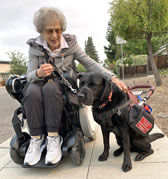
Back to top
 Projects with Abby Projects with Abby
-
2022 Biosketch: Abby
is an artist, a retired art teacher (grades K-College), a clinical social
worker, and a computer graphic designer. She is an individual with multiple
disabilities: a mobility challenge, a bipolar disorder, and a visual
impairment. She is passionate about making a difference and advocating for
individual rights. She has been a chair of the
Consumer
Advisory Council and formerly represented consumers on the Board of
Directors of the National Alliance on
Mental Illness (NAMI) in Santa Clara County and has volunteered in their
Connection
Recovery Support Group and the
Peer
PAL Program. She has also volunteered for the
Vista Center for the Blind and Visually
Impaired, has been on the
Board of Directors
of the Silicon Valley Independent Living
Center (SVILC), has successfully been involved in litigation to preserve
the rights of service dog recipients when they are hospitalized, and has
presented Poster Sessions and spoken at conferences including NAMI’s
National Convention, California ADA (Americans with Disabilities Act) 2015
Conference celebrating 25 years, the California Council of the Blind’s
Annual Convention, Cal Poly Tech Women
in Business, Defining Her Future
2021 panel on Diversity, Equity, and Inclusion. Abby has mentored
elementary school students with art lessons and partnered with high school
students in programs for Project Invent
and Design the Future. She has
been interviewed for a
podcast
by Project Invent and was the speaker last February for a Jewish Disability
Awareness, Acceptance & Inclusion Month (JDAIM) event (video 13:06). Abby invented a board game
for inpatient psychiatric units. She has a successor service dog, Nathan, from
Canine Partners for Life (CPL) in
Cochranville, PA, and has presented
Service Dog
Demonstrations at Abilities Expo in 2019. Abby has supported products that
increase functionality for individuals with disabilities ("How I overcame
vision loss with eSight" - video
4:30). She is presently a graduate student at California State University Northridge studying
Assistive Technology
Studies and Human Services.
| Back to top
Communication Aid for Nathan
-
Background: Abby
is an older adult who relies on a powered wheelchair for her mobility and her
service dog, Nathan, to help her with daily tasks.
-
Problem: "A
major problem for service dog recipients is the constant baby talk and thoughts
by many of the general public that a service dog is their dog fix for the day,
with total disregard for the owner of the dog, or the reason the dog is with
the owner."
-
Aim: Explore
designs for a device that would "speak for Nathan", informing people that he is
"on the job" and not available to be petted or engage in human-canine
conversation.
-
Design
Criteria:
- Easy access to
activation mechanism on right side of Abby's wheelchair
- Easy activation
while operating wheelchair and controlling Nathan
- Loud enough for
people to be alerted in noisy environments
- Supports several
vocalizations and volumes
-
Links:
-
Recommended
Skillset: Mechanical Engineering, Electronics
|
| Back to top
Alert Project for Abby
-
Background:
"Another project I am interested in is some kind of an audible alert that I
could easily press to alert people that I am passing. I had this idea for
Project Invent two summers ago, and the
solution one team was working on was playing a recording of my voice very loud
saying "Passing By", "Coming Through", or "Excuse Me". My thought is that a
device would attach to the right arm of the WHILL so that I would have easy
access to press on it. I have looked at bicycle bells, horns, etc. The problem
I have is using both hands with Nathan and the WHILL, and not being able to
hold something else. Bicycle bells are for rounded handlebars, and don't fit
the WHILL arm, plus you have to turn them, press something small on them, or
some other way of getting the noise that I can't do. The noise has to be loud
enough for people to hear it."
-
Problem: In
crowded spaces, people are not often aware of a wheelchair user trying to
negotiate the "walking traffic", increasing the possibility of
collisions.
-
"This is a huge problem
everywhere I go outside in the community, or in buildings. Many times an
individual's attention is not on where they are walking, or how their walking
patterns may affect someone coming from behind in a powered
wheelchair."
-
Aim: Explore
designs to alert people in Abby's path.
-
Design
Criteria:
- Easy access to
activation mechanism on right side of Abby's wheelchair
- Easy activation
while operating wheelchair and controlling Nathan
- Loud enough for
people to be alerted in noisy environments
- Several alert modes
and volumes
-
Other:
-
Links:
-
Recommended
Skillset: Mechanical Engineering, Electronics
|
| Back to top
Rain Shield Project
-
Background: Abby
is an older adult who relies on a powered wheelchair for her mobility and her
service dog, Nathan, to help her with daily tasks.
-
Problem:
Wheelchair users and their mobility devices must be protected from the rain as
being wet is uncomfortable and water can damage electronics.
-
Aim: Explore
designs for a suitable covering (a garment or wheelchair / scooter accessory)
to protect Abby and her mobility device.
-
Design
Criteria:
- Suitable for use
with Abby's scooter and Whill
- Aesthetic
design
- Collapsible and
stowable
- Easy to put on and
remove and/or easy to deploy and retract
-
Search Link:
"rain protection for wheelchair user"
-
Recommended
Skillset: Mechanical Engineering, Shop
|
| Back to top
Large Art Drawing Board
-
Problem:
Artists, like Abby, who are wheelchair users may not be able to employ standard
easels, especially when drawing outdoors and using large format
media.
-
Aim: Explore
designs for a drawing board that will support large format art
media.
-
Design
Criteria:
- Must attach to
Abby's mobility devices
- Must accommodate
large art media (size = 20 by 17 inches)
- Collapsible and
stowable
- Easy to deploy and
retract
- Art media can be
securely fastened to drawing board
- Drawing board must
be able to be re-positioned (able to be tilted)
-
Search Link:
"wheelchair easels"
-
Recommended
Skillset: Mechanical Engineering, Shop
|
| Back to top
Accessible Storage Solution
-
Problem:
Wheelchair users, like Abby require storage space for many large and small
accessories such as a coat, laptop, keys, cellphone, water bottle, and items
for service dogs including treats, food, blanket, leash, etc. Current storage
solutions are attached behind the wheelchair, which makes retrieving items
challenging.
-
Aim: Explore
designs for an accessible storage solution.
-
Design
Criteria:
- Easy to pack and
retrieve items
- Compartments for
large and small items
- Provide security
from theft
-
Other:
-
Search Link:
"wheelchair storage"
-
Recommended
Skillset: Mechanical Engineering, Shop
|
| Back to top
Leash Project for Abby and Nathan
-
Problem:
Wheelchair and scooter users like Abby can have a difficult time simultaneously
operating their mobility device and controlling their service
animal.
Problem:
"Operating my Whill wheelchair while controlling my service dog Nathan with a
leash is a real challenge. The leash has to be able to go on either side, or in
front and back of the chair, while at the same time be short enough to avoid
getting caught in the front wheels or the arm rests. I was recently at IKEA,
and the leash I was using got twisted around one of the front wheels under the
wheel cover. This is a dangerous situation for me as well as Nathan. As he is
with me wherever I go, this presents a continual problem in our lives." -
Abby
-
Aim: Explore
ways to make it easier for Abby to operate her wheelchair and control
Nathan.
-
Design
Criteria:
- The design should
not alter or permanently deface or damage the physical structure of the
wheelchair.
- The customization
should be able to easily be installed, removed, changed, cleaned, and washed by
the use
- The design should be
inexpensive and easy to fabricate.
- Consider designs
that would enhance wheelchair visibility at night, especially when crossing
streets.
-
Links:
-
Recommended
Skillset: Mechanical Engineering, Shop
|
|
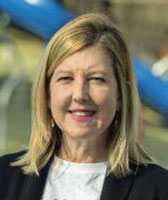
Back to top
 Projects with Olenka at the Magical Bridge Playground Projects with Olenka at the Magical Bridge Playground
Accessible and Inclusive Playground Attractions
-
-
Background: The
Magical Bridge Playground is
recognized as the nation's most innovative accessible and socially inclusive
playground. It is designed to delight the many people who make up our
community, including the 1 in 4 living with a visible or invisible disability
who are typically overlooked in the creation of public playgrounds. It is a
multigenerational play space with areas for respite, along with thoughtful
programs which include
Kindness
Ambassadors. The original playground was spearheaded by Palo Alto citizen
volunteer and former tech executive, Olenka (Villarreal). Along with dozens of
volunteers and 0.8 acres of underutilized public land in Mitchell Park, she was
determined to create the most magical playground to bridge the gap between
those with and without disabilities in such a seamless way that everyone would
love it. Located at
600
East Meadow Drive in Palo Alto, the volunteers raised $4.2M in private
funds to showcase how a truly inclusive playground creates a welcoming spirit
for a community. Magical Bridge Playground is adjacent to
AbilityPath and close to
Ada's Cafe and the
Mitchell Park
Library.
-
The
playground
opened in April 2015 and enjoys an average of 25,000 visitors a month. Many
are local families, while others come from long distances.
-
After this playground
was completed, Magical Bridge
Foundation was formed in 2016 with a mission to advocate for more inclusive
play spaces and programs that consider the needs of all ages and all abilities.
The foundation now has 12 new destination playgrounds under construction, and
is also developing an exciting plan for elementary school playgrounds to put
more magic into recess! Besides Palo Alto, Redwood City, Addison Elementary
School and CuriOdyssey Museum and Zoo are
now proud to have a Magical Bridge of their own. International sites are also
underway.
-
Problem: The
park's play equipment has been well-received, but some aspects of the play
areas could be modified for better access. In addition, suggestions for
replacement play areas are sought to update the park with innovative
installations every few years. And as new Playgrounds are planned and
constructed, there are ongoing opportunities to design new features and refine
existing designs to be accessible to everyone regardless of their
abilities.
-
Aim: Explore
designs to improve access to and navigation around the playground, as well as
to create new play and educational experiences incorporating multiple senses,
actions, and outcomes for all playground users and visitors, especially those
with visual impairments and diminished fine motor skills.
-
Design
Criteria:
- Designs should be
durable, fun, and safe for everyone - accommodating children and parents with
disabilities - and be magical for all ages and all abilities.
- Project prototypes
could be scale models to facilitate their construction and
transportation.
- Designs that
incorporate electronics should be low-voltage or solar-powered.
-
Recommended
Skillset: Mechanical Engineering, Mechatronics, depends on selected design
concept
-
Links:
|
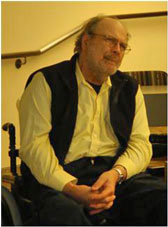
Back to top
 Projects with Nick Z Projects with Nick Z
-
Background: Nick Z is
an experienced manual wheelchair rider. In addition to propelling himself, he
performs occasional "push-ups" to relieve pressure on his buttocks to prevent
pressure sores.
| Back to top
Adjustable Wheel Locks
-
Problem: The air
pressure in Nick's wheelchair tires varies over time, affecting the ability of
the existing wheel lock mechanism to fully secure the wheelchair during
transfers.
-
Aim: Explore
wheel lock designs that would accommodate varying tire
pressures.
-
Design
Criteria:
- The design must not
require a tool for adjustments.
- The design must
provide a linear range of adjustment.
-
Other:
- Project work will be
performed with a Stanford-owned wheelchair to avoid damaging Nick's
wheelchair.
-
Link:
-
Recommended
Skillset: Mechanical Engineering, Shop
|
| Back to top
Personal Item Organization and Storage
-
Problem: Nick
experiences challenges storing and locating the personal items he carries with
him daily. Such items include sunglasses, hand tools, pens, papers, books,
notebooks, and a water bottle.
-
Aim: Explore
designs for a way to store and organize Nick's personal items when he is on the
go or at home.
-
Design
Criteria:
-
Links:
-
Recommended
Skillset: Mechanical Engineering, Shop
|
| Back to top
Improved Wheelchair Caster Wheel Project
-
Problem: During
direction changes, existing caster wheels on manual wheelchairs require space
to pivot around and increase propulsion effort.
-
Aim: Explore
non-castering omni-wheels as a caster wheel replacement.
-
Design
Criteria:
- Be a "plug-in
replacement" for the existing caster wheels
- Be durable and
strong enough to support the rider
- Require measurably
less effort to propel the wheelchair
-
Links:
-
Recommended
Skillset: Mechanical Engineering, Shop
|
|

Back to top
 Projects with Kate & McKenzie at the Cantor Arts
Center Projects with Kate & McKenzie at the Cantor Arts
Center
-
Background: Serving
the Stanford campus, the Bay Area community, and visitors from around the
world, the Cantor Arts Center
provides an outstanding cultural experience for visitors of all
ages.
-
Problem: Blind folks
and folks with low vision may have trouble navigating the Cantor Arts Center
building, getting resources from staff, reading labels, and engaging with the
artwork on display as a way of providing them with a better museum experience
and improve accessibility to the building and exhibitions.
| Back to top
Exhibition Engagement Tool
-
Aim: Develop a
tool - possibly an app - that will allow blind visitors and visitors with low
vision to better engage with artworks on display.
-
Design Criteria:
- The tool or app
should provide an audio description of artworks on permanent display as well as
museum engagement activities.
- The tool or app
should be easy to operate and interact with.
-
Other:
- App solutions could
be downloaded to visitors' smartphones or could be provided for loan on a
museum-supplied tablet.
- Museum visitors with
other disability conditions could also be addressed - such as those who are
wheelchair users or who use service animals.
-
Links:
|
| Back to top
A Day at the Cantor Arts Center
-
Aim: Document
the experience of a blind person or person with low vision as they navigate the
Cantor, including entering and exiting the building, moving through gallery
spaces, locating facilities like restrooms and the cafe, and engaging with
artworks on display.
-
Design Criteria:
- The documentation
may take the format of a film, video, or other media.
- The production of a
5-minute film or video would be a suitable outcome for an Individual Project,
while a longer film or video with a 5-minute trailer would be an appropriate
Team Project.
-
Other:
- These projects will
help museum staff to better understand how well they are doing well and what
they need to improve to help their blind/low vision visitors to have a fuller,
more satisfying experience at the museum.
- Museum visitors with
other disability conditions could also be addressed - such as those who are
wheelchair users or who rely on service animals.
|
|
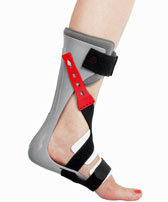
Back to top
 Improved Ankle Foot Orthosis Mold with Gary Improved Ankle Foot Orthosis Mold with Gary
-
Background: Ankle foot
orthoses (AFOs) are externally worn biomechanical devices utilized on lower
limbs to stabilize the ankle and foot joints, improve the gait and physical
functioning of the affected lower limb. They are used as supportive devices and
aid for ambulation through different gait stages by providing foot clearance,
used to limit or assist ankle and foot range of motion (ROM) such as
dorsiflexion and plantar flexion, improve balance, decrease the risk of
falling, help with weak musculature of lower legs, and improve patient
mobility.
-
Problem: An AFO is
made from a mold of the patient's limb while sitting but may not duplicate the
more physiologically important standing alignment.
-
Aim: Explore designs
for a tri-planer lower limb alignment AFO capture system that can accurately
capture the standing alignment from a sitting position mold for proper AFO
casting and function.
-
Design
Criteria:
- appropriate for use in a
clinic
- must accurately record
anatomical and placed landmarks - either mechanically or digitally - on foot
and ankle so the AFO can be aligned in the frontal, sagittal, and coronal
planes
-
Link:
-
Recommended Skillset:
Mechanical Engineering, Shop
|
|
Back to top
 Project for Nick J - Video Therapy Documentation Project for Nick J - Video Therapy Documentation
-
Background: Nick J is
a resident of Sunnyvale and a stroke survivor.
"In 1994 I had a stroke which
injured my brain's basal ganglia region, resulting in hemiplegia on my left
side. After three days in intensive care, I was released to the brain injury
rehab unit of Stanford Hospital where I received excellent therapy as an
inpatient for about one month. For most of that time I needed a wheelchair.
When I left, I could walk with difficulty using a cane. I continued therapy,
twice a week, as an outpatient at a clinic in Los Gatos. Through intensive
self-therapy, building on what I had learned, I have made a good recovery. I am
85 and am able to hike and bicycle."
-
Aim: Nick would like
to video document his self-therapy exercise efforts with the goal of helping
other stroke survivors.
-
Links:
-
Recommended Skillset:
Video production
|

Back to top
 Project with Jorge - Ski Pole Project with Jorge - Ski Pole
-
Background: "My left
arm and hand do not have full range of motion resulting in my forearm and hand
being stuck palm up (supine) position."
-
Problem: "When I ski,
I can’t hold a traditional pole in a such way that I can use it. If I hold
a ski pole with my hand supine, the pole points horizontally (towards my right
hand) at the level of my stomach."
-
Aim: Explore designs
for a new or modified ski pole that would enable Jorge to better participate in
skiing.
-
Design
Criteria:
- Accommodates Jorge's hand
/ arm
- Provides a natural
shoulder position during skiing
- Prevents pole from being
dropped
-
Link:
|
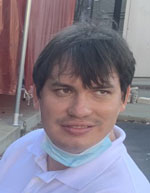
Back to top
 Projects with Danny Projects with Danny
-
Background: Danny is a
wheelchair user from Los Gatos with cerebral palsy. He experiences limited
upper body strength, grip and vision impairments, and diminished hand and
finger dexterity.
|
Back to top
 Dog Feeding Aid Dog Feeding Aid
- Problem: While
Danny can scoop dry food to fill his service dog's (Korey) bowl, his limited
upper body range of motion, weak grip strength, and impaired vision prevents
him from lifting the bowl and lowering it to the floor.
-
Aim: Explore
designs that would enable Danny to independently feed Korey.
-
Design
Criteria:
- Easy to
operate
- Will not spill
Kory's food
- Not an "automatic
feeding system"
-
Recommended
Skillset: Mechanical Engineering, Shop
-
Links:
|
|
Back to top
 Belt Buckle Project Belt Buckle Project
- Problem: Due to
Danny's vision and grip impairments, he experiences difficulties securing the
"seat belt" safety restraint system on his current wheelchairs.
-
Aim: Explore
design solutions that would make it easier for Danny to buckle himself into his
wheelchairs independently.
-
Design
Criteria:
- Easy to buckle and
unbuckle
- Will not unbuckle
spontaneously during wheelchair activities
-
Recommended
Skillset: Mechanical Engineering, Shop
-
Links:
|
|
Back to top
 Scoot-Back Project Scoot-Back Project
- Problem: After
some wheelchair activities, Danny begins to slouch in his seat.
-
Aim: Explore
design solutions that 1) would identify the slouched condition and 2) would
enable Danny to independently restore himself to an upright seated
position.
-
Design
Criteria:
-
Recommended
Skillset: Mechanical Engineering, Electronics, Shop
-
Links:
|
|
Back to top
 Wearable Storage Pack Wearable Storage Pack
-
Problem: Danny
experiences limited upper body strength, grip and vision impairments, and
diminished hand and finger dexterity. This interferes with his ability to put
his phone into his existing Fanny pack. When he tries to do so, it falls on the
ground. It is also difficult for him to secure and zip his existing
pack.
-
Aim: Explore
designs for a wearable storage pack that would enable Danny to independently
and safely store his phone, wheelchair gloves, and other miscellaneous
objects.
-
Design
Criteria:
- Easy to put on and
take off independently
- Appropriately sized
opening
- Large enough to
securely hold a phone, gloves, and other small objects
- Easy to open and
close
- Cool
looking
-
Recommended
Skillset: Mechanical Engineering, Electronics, Shop
-
Links:
|
|
|
 Projects Suggested by Dave: Projects Suggested by Dave:
|
Back to top
Designing Your Afterlife
-
Background:
Death is the most severe form of disability as one is no longer able to
interact with people or physical objects in the living world. What remains are
only frozen static artifacts - images, writings, and the stories of others.
Gone are one's personality, beliefs, expertise, humor, vision, memories,
insights, and intellect.
-
Problem: With
one's passing, it is impossible to provide a full and accurate representation
of whom they were, what they believed in, and how they acted. The recollections
of family and friends fade and disappear with time, leaving the departed one's
legacy at the mercy of the living.
-
Aim: Explore
ways to preserve one's essence after death. In the technology extreme, this
might manifest itself as an interactive system that responds to queries,
retells stories, relates experiences, shares expertise, and expresses humor.
The pre-dead user would be able to create and program his / her eternal
computer-based persona before her / his demise.
-
Other:
-
Recommended
Skillset: Various, depends on chosen solution
-
Links:
|
|
Back to top
Creative Expression
-
Background: Most
everyone has a desire to be creative through activities such as writing,
painting, sculpture, pottery, jewelry, quilting, photography, singing, dancing,
and music.
-
Problem:
Existing tools supporting creativity are often lacking for people with
disabilities. Movement difficulties may prevent an individual from fully
participating in their chosen activity.
-
Aim: Explore
ways to enhance creative expression for people with disabilities. This could
include the creation of new activities or fabrication of new
tools.
-
Suggestions:
- Convert the user's
existing assistive technology device into a creative "paintbrush" or "musical
instrument"
- Use non-traditional
inputs such as residual movements or brain waves
- Adapt or create
instruments for musicians with disabilities
- One-Handed Musical
Instrument (OHMI) Competition
-
Other:
-
Recommended
Skillset: Various, depends on chosen solution
-
Links:
|
|
Back to top
Student-defined Projects
-
- Meet with the course
instructor to discuss and agree upon the specifics of the project. Interview,
observe, and discuss assistive technology problems with an individual with a
disability or older adult. Address their desire to participate in one of the
following activities by designing an adaptation to an existing device / tool or
creating a new, more useful one. Projects could address:
-
-
Activities
of Daily Living - cooking, showering or bathing, dressing, cleaning,
housework, yard work, employment, education, shopping, commuting,
etc
-
Sports and
Exercise - walking, running, indoor and outdoor sports, etc
-
Leisure
Activities and Hobbies - collecting, model making, crafts, board games
& videogames, etc
|
|
|
Back to top
 Title Title
-
Background:
-
Problem:
-
Aim:
-
Design Criteria:
-
Links:
|
Back to
top
|